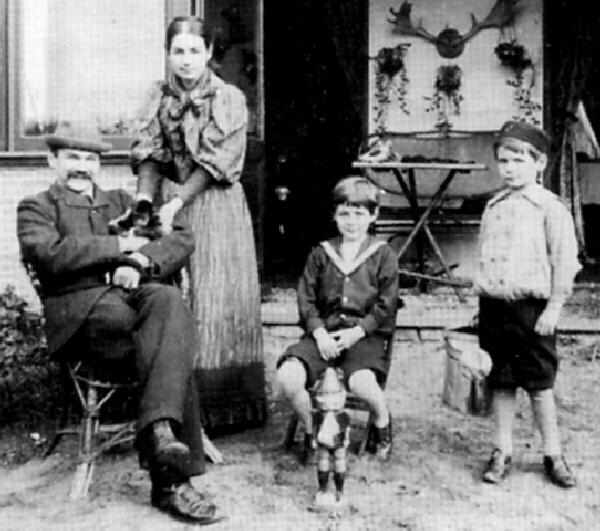
Biographies: Frederik Williem van Eeden - (Netherlands, 1860-1932):

Figure 1.--Here we see the van Eeden family in 1895. It shows an affluent middle-class family in the 1890s. Note the round brimless cap. I'm not sure what they were called, but we note them being worn in the late 19th century, in both Europe and America. Also notice the light-colored long stockings. Dark stockings were more common at the time.
|
Williem Van Eeden was an important Dutch philosopher. Van Eeden's works, according to the Encyclopaedia Britannica, "reflect his lifelong search for a social and ethical philosophy. A family snapshot shows
and his first wife Martha (1856-1943) with their two sons Paul (1889-1913) and Hans (1887-1981). The photograph was
taken in Holland in 1895 and is a good example of clothing styles in an affluent Dutch middle-class family.
Parents
Childhood
Education
Van Eeden studied medicine at Amersterdam.
Career
Van Eeden with two other writers, Willem Kloos and Albert Verwey, founded in 1885 De nieuwe gids, a literary periodical
devoted to modern authors and new social ideas. Later he started a clinic for physical therapy at Bussum, near Hilversum. In 1898 he founded Walden, an agricultural colony based on the concepts of the American writer, Henry David Thoreau. He was especially interested in social ethics. "After much doubt and
disappointment," according to the Britannica article, he became a Roman Catholic (1922). In his early days, van Eeden was known for the most part outside the Netherlands for his socially idealistic theories. But his reputation rests finally on his written works such as De kleine Johannes (1885); The Quest (1907), a symbolic fairy tale. He also wrote a long
philosophical poem, "Het lied van schijn en wezen" (Song of Semblance and Substance," first part, (1895). A novel, Van de koele meren des doods (1900); "The Deeps of Deliverance," (1902), is based on his psychiatric experience. Van Eeden's criticism and social treatises were collected in "Studies," 6 volumes (1890-1918). He was also the author of many plays and
in addition translated the Indian poet Tagore's work into Dutch.
Family
Here we have a family snapshot. Van Eeden's son Paul, 6 years old, wears a sailor suit with buttons down the front and knee pants. Hans, 8 years old, wears a blouse with a wide collar and knickers. Interestingly, both boys wear tan long stockings rather than black ones. Tan stockings for boys, replacing the more formal
black, only became popular in Europe in the 1920s, so it is unusual to see them as early as 1895. Perhaps Van Eeden's liberal social ideas had something to do with the apparently avant garde fashion in this instance.
HBC

Navigate the Boys' Historical Clothing Web Site:
[Return to the Main biography D-F page]
[Return to the Main German individual experiences page]
[Introduction]
[Activities]
[Biographies]
[Chronology]
[Clothing styles]
[Countries]
[Institutional wear]
[Bibliographies]
[Contributions]
[FAQs]
[German glossary]
[Satellite sites]
[Tools]
[Boys' Clothing Home]
Created: 2:29 AM 12/15/2004
Last updated: 2:29 AM 12/15/2004



